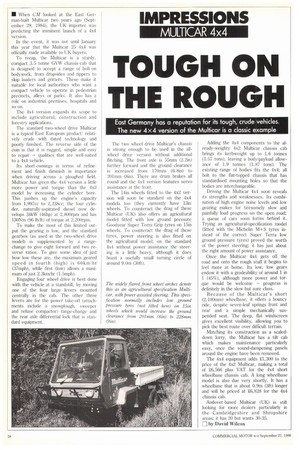TOUGH ON THE ROUGH
Page 60

If you've noticed an error in this article please click here to report it so we can fix it.
East Germany has a reputation for its tough, crude vehicles. The new 4x4 version of the Multicar is a classic example • When CM looked at the East German-built Multicar two years ago (September 29, 1984). the UK importer was predicting the imminent launch of a 4x4 version.
In the event, it was not until January this year that the Multicar 25 4x4 was officially made available to UK buyers.
To recap, the Multicar is a sturdy, compact 3.5 tonne GVW chassis-cab that is designed to accept a range of bolt-on bodywork, from dropsides and tippers to skip loaders and gritters. These make it suitable for local authorities who want a compact vehicle to operate in pedestrian precincts, alleys or parks. It also has a role on industrial premises, hospitals and so on.
The 4x4 version expands its scope to include agricultural, construction and forestry applications.
The standard two-wheel drive Multicar is a typical East European product: relati vely crude with dated technology and poorly finished. The reverse side of the coin is that it is rugged, simple and easy to repair — qualities that are well-suited to a 4x4 vehicle.
Its short-comings in terms of refinement and finish diminish in importance when driving across a ploughed field.
Multicar has given the 4x4 version a little more power and torque than the 4x2 model by increasing the cylinder bore.
This pushes up the engine's capacity from 1,997cc to 2,238cc; the four cylin der, naturally-aspirated diesel now develops 34kW (46hp) at 2,800rpm and has 130Nm (96 lb/ft) of torque at 2,200rpm.
To make the most of this limited output the gearing is low, and the standard gearbox (as used in the two-wheel drive model) is supplemented by a rangechange to give eight forward and two re verse ratios. To give some idea of just how low these are, the maximum geared speed in fourth (high) is 60km/hr (37mph), while first (low) allows a maximum of just 2.3km/hr (1.5mph).
Engaging four wheel drive is best done with the vehicle at a standstill, by moving one of the four large levers mounted centrally in the cab. The other three levers are for the power take-off (attach ments include a snowplough, sweeper and refuse compactor) range-change and the rear axle differential lock that is standard equipment. The two wheel drive Multicar's chassis is strong enough to be used in the ailwheel drive version without additional flitching. The front axle is 55mm (2.2in) further forward and the ground clearance is increased from 170mm (6.8in) to 201rnm (Sin). There are drum brakes all round and the 4x4 version features servo assistance at the front.
The 14in wheels fitted to the 4x2 version will soon be standard on the 4x4 models too (they currently have 13in wheels. To counteract the drag of these Multicar (UK) also offers an agricultural model fitted with low ground pressure Goodyear Super Terra Grip tyres on 15in wheels. To counteract the drag of these tyres, power steering is also fitted on the agricultural model; on the standard 4x4 without power assistance the steering is a little heavy, although it does boast a usefully small turning circle of around 9.0m (30ft). Adding the 4x4 components to the already-weighty 4x2 Multicar chassis cab brings its kerbweight up to 1.6 tonnes (1.57 tons), leaving a body/payload allowance of 1.9 tonnes (1.87 tons). The existing range of bodies fits the 4x4; all bolt to the flat-topped chassis that has standardised mounting holes so that the bodies are interchangeable.
Driving the Multicar 4x4 soon reveals its strengths and weaknesses. Its combination of high engine noise levels and low gearing makes for tiresomely slow and painfully loud progress on the open road; a queue of cars soon forms behind it. Trying an agricultural-specification model (fitted with the Michelin M+S tyres instead of the correct Super Terra low ground pressure tyres) proved the worth of the power steering; it has just about the right amount of power assistance.
Once the Multicar 4x4 gets off the road and onto the rough stuff it begins to feel more at home. Its low, low gears endow it with a gradeability of around 1 in 1 (45%), although more power and torque would be welcome — progress is definitely in the slow but sure class.
Because of the Multicar's short (2,100mm) wheelbase, it offers a bouncy ride, despite seven-leaf springs front and rear and a simple mechanically suspended seat. The deep, flat windscreen gives excellent visibility, allowing you to pick the best route over difficult terrain.
Matching its construction as a scaleddown lorry, the Multicar has a tilt cab which makes maintenance particularly easy, once the sound-dampening panels around the engine have been removed.
The 4x4 equipment adds £1,300 to the price of the 4x2 Multicar, making a total of £6,566 plus VAT for the 4x4 short wheelbase chassis cab. A long wheelbase model is also due very shortly. It has a wheelbase that is about 0.9m (3ft) longer and will be priced at £6,828 for the 4x4 chassis cab.
Andover-based Multicar (UK) is still looking for more dealers particularly in the Cambridgeshire and Shropshire areas; it has 20 but wants 30-35.
El by David Wilcox
















































































































